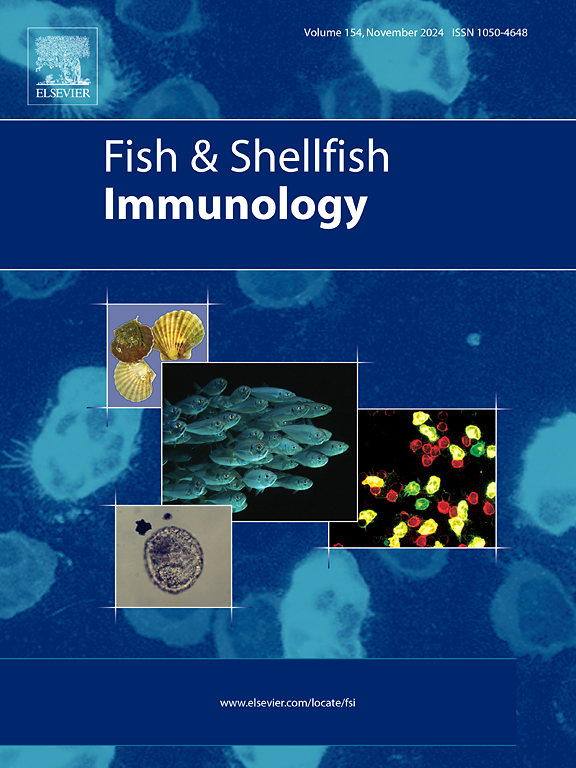Passive immunoprophylaxis with Ccombodies against Vibrio parahaemolyticus in Pacific white shrimp (Penaeus vannamei)
IF 4.1
2区 农林科学
Q1 FISHERIES
引用次数: 0
Abstract
The Vibrio parahaemolyticus strain causing acute hepatopancreatic necrosis disease (AHPND) in shrimp secretes toxins A and B (PirAVp/PirBVp). These toxins have been implicated in pathogenesis and are targets for developing anti-AHPND therapeutics or prophylactics that include passive immunization. We have previously reported that Ccombodies (recombinant hagfish variable lymphocyte receptor B antibodies; VLRB) targeting PirBVp conferred protection against V. parahaemolyticus in shrimp when administered as a feed supplement. In this study, we screened a phage-displayed library of engineered VLRBs for PirAVp-targeting Ccombodies that were mass-produced in a bacterial expression system. We then introduced these Ccombodies into the diet of Pacific white shrimp (Penaeus vannamei) over a seven-day period. Subsequently, the shrimp were exposed to a challenge with V. parahaemolyticus. Mortality rates were then observed and recorded over the following seven days. Administering shrimp feed supplemented with Ccombodies at a high dose (100 mg per 100 g feed) reduced mortality in recipient animals (2.96–5.19 %) statistically similar to mock-challenged control (1.48 %), but significantly different from the Ccombody-deficient control (74.81 %). This suggests that the Ccombodies provided strong protection against the bacterium. Feeding shrimp with a median dose (10 mg/100 g feed) gave statistically comparable low mortality (5.93–6.67 %) as the high dose. Reducing the Ccombody dose to 1 mg/100 g feed showed variable effects. Ccombody A2 showed mortality (11.85 %) significantly lower than that of the Ccombody-deficient group (74.81 %), suggesting that it can effectively protect against the bacterial challenge at a low dose. Our results demonstrate the ability of the phage-displayed VLRB library to generate antigen-specific Ccombodies rapidly and simply, with the expression of high protein levels in bacteria. The protective effect provided by these Ccombodies aligns with our earlier results, strongly supporting the use of VLRB antibodies as a substitute for IgY in passive immunoprophylaxis against AHPND in shrimp.
用Ccombodies对太平洋南美白对虾(Penaeus vannamei)的副溶血性弧菌进行被动免疫预防。
引起对虾急性肝胰腺坏死病(AHPND)的副溶血性弧菌菌株会分泌毒素 A 和 B(PirAVp/PirBVp)。这些毒素与致病机理有关,是开发抗 AHPND 治疗药物或包括被动免疫在内的预防药物的目标。我们以前曾报道过,以 PirBVp 为靶标的 Ccombodies(重组姬鲷可变淋巴细胞受体 B 抗体;VLRB)作为饲料添加剂可保护对虾免受副溶血性弧菌感染。在这项研究中,我们从噬菌体展示的工程化 VLRB 库中筛选出了 PirAVp 靶向 Ccombodies,并在细菌表达系统中进行了大规模生产。然后,我们在太平洋白对虾(Penaeus vannamei)的食物中引入这些 Ccombodies,为期七天。随后,对虾接受副溶血性弧菌的挑战。在随后的七天中观察并记录死亡率。在对虾饲料中添加高剂量(每 100 克饲料 100 毫克)的科氏抗体,可降低受体动物的死亡率(2.96%-5.19%),在统计学上与模拟挑战对照组(1.48%)相似,但与缺乏科氏抗体的对照组(74.81%)有显著差异。这表明,Ccombodies 提供了对细菌的强大保护。用中位剂量(10 毫克/100 克饲料)喂养对虾,死亡率(5.93%-6.67%)与高剂量相当。将 Ccombody 剂量降至 1 毫克/100 克饲料的效果不一。Ccombody A2 的死亡率(11.85%)明显低于 Ccombody 缺乏组的死亡率(74.81%),这表明低剂量的 Ccombody A2 可有效抵御细菌挑战。我们的研究结果表明,噬菌体展示的VLRB库能够快速、简单地生成抗原特异性Ccombodies,并在细菌中表达高水平的蛋白。这些Ccombodies所提供的保护效果与我们之前的研究结果一致,有力地支持了使用VLRB抗体替代IgY对对虾进行被动免疫预防AHPND。
本文章由计算机程序翻译,如有差异,请以英文原文为准。
求助全文
约1分钟内获得全文
求助全文
来源期刊

Fish & shellfish immunology
农林科学-海洋与淡水生物学
CiteScore
7.50
自引率
19.10%
发文量
750
审稿时长
68 days
期刊介绍:
Fish and Shellfish Immunology rapidly publishes high-quality, peer-refereed contributions in the expanding fields of fish and shellfish immunology. It presents studies on the basic mechanisms of both the specific and non-specific defense systems, the cells, tissues, and humoral factors involved, their dependence on environmental and intrinsic factors, response to pathogens, response to vaccination, and applied studies on the development of specific vaccines for use in the aquaculture industry.
 求助内容:
求助内容: 应助结果提醒方式:
应助结果提醒方式:


